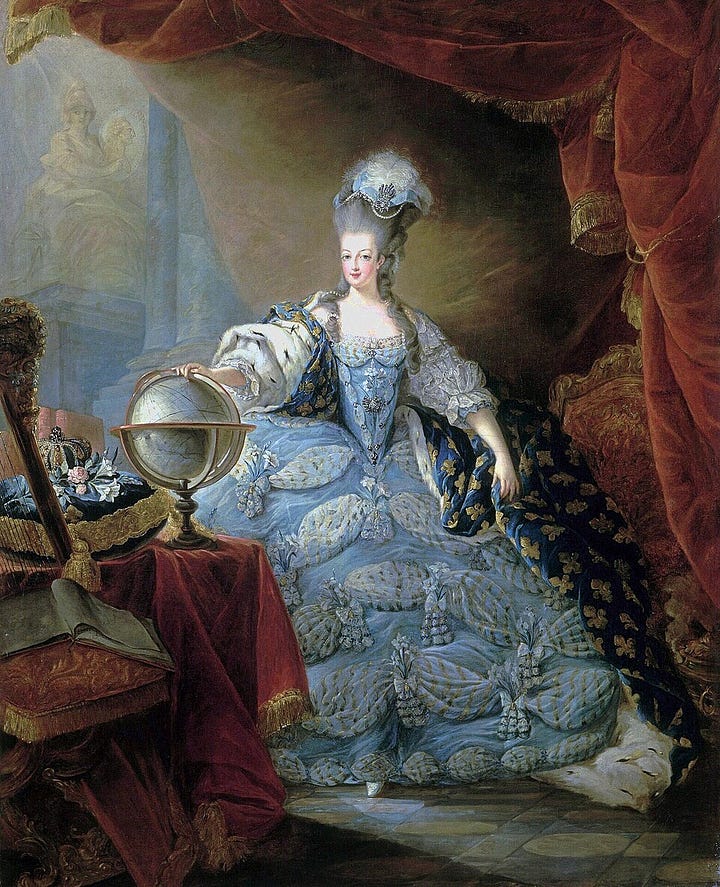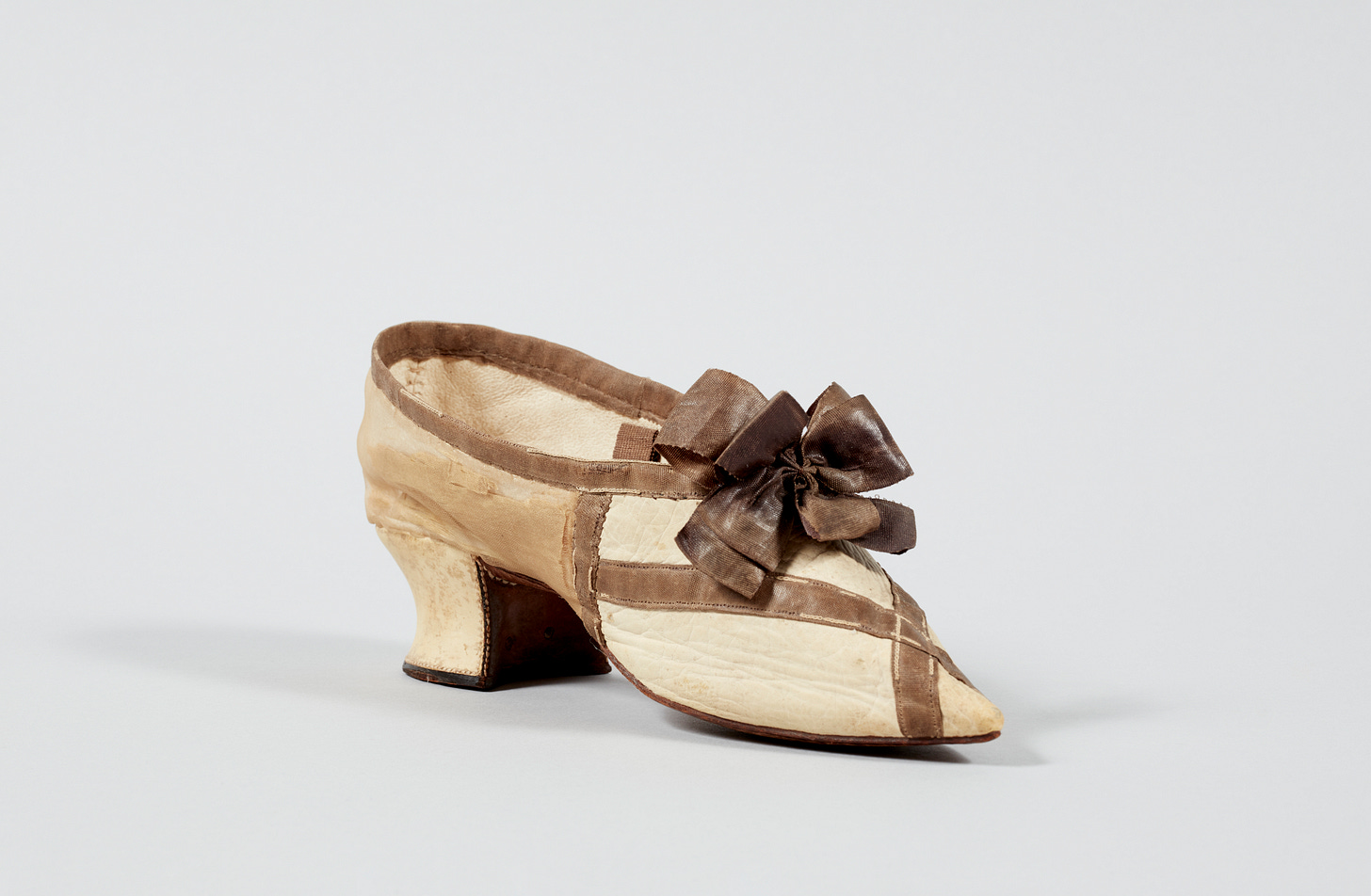Marie Antoinette's Wardrobe
A History of Absence
Marie Antoinette’s wardrobe has become, over the centuries, synonymous with luxury and caprice. But to open it today — in museums, in ledgers, in fragments — means discovering an almost empty closet.
The exhibition recently opened at the Victoria and Albert Museum made me think about how much material from the queen’s legendary wardrobe survives today.
Little to nothing is the answer: history has been unkind.
How to Dismantle a Royal Gown: The Court Machine
It’s not just the Revolution’s fault.
The dispersal of Marie Antoinette’s wardrobe was inherent in court practices themselves and, more broadly, in the material culture of eighteenth-century France.
Out-of-fashion garments were given to servants, ultimately contributing to the growth of a thriving secondhand clothing market. The queen herself did this: Madame Campan recalls in her Mémoires that dismissed garments were handed over to her dame d’atours, who resold them for her own profit.
Other pieces were instead reworked and reformed for the next season.
The concept of disposable clothing is a modern one; in contrast, in the eighteenth century, even court garments were intended to be reused.
Fine and expensive fabrics (like Lyonnaise silks) lent themselves to new lives, over and over again.
The Second Erasure: Revolution and Dispersals
And then, of course, came the Revolution.
In 1789, the assault on the palace of Versailles forced the royal family to move to Paris, to the Tuileries residence, where they lived under arrest while formally maintaining court customs.
But on August 10, 1792, a second, bloody assault on the Tuileries ended the monarchy and led the royal family to Temple Prison.
The palace was ransacked: goods destroyed, stolen, or scattered. What remained was then auctioned off by the revolutionary government.
The Musée Carnavalet preserves a shoe attributed to Marie Antoinette, the last fragment of her wardrobe, which survived the fury of the crowd on that distant August 10, 1792.
Who knows what became of the other one?
After the assaults and public sales came what we might call an “economy of relics”.
What little had survived was taken apart, divided into pieces, and redistributed to become devotional objects for nostalgic monarchists.
An emblematic case is the fragment of a court dress underskirt, now at the Museum of London: a scrap of ivory silk embroidered with gold thread, perhaps belonging to one of the queen’s ceremonial gowns.
It’s not a dress, but a piece of clothing. Yet it tells more than any reconstruction: at the queen’s death, its owners cut up the garment and distributed it in pieces as a royal relic.
The Last Garments
Marie Antoinette’s imprisonment lasted little more than fourteen months, first at the Temple Prison and then at the Conciergerie.
She was executed on October 16, 1793.
Another relic is preserved today in Paris: a chemise said to have been worn by Marie Antoinette during her detention.
This is not the chemise à la reine made famous by Élisabeth Vigée-Le Brun’s contested 1783 portrait, but an everyday chemise (shift), an undergarment worn beneath clothes.
Here is how the queen, stripped of her ceremonial armor, spent the final months of her life: an ordinary citizen dressed in plain fabric, as fragile as her own condition.
The Dress That Isn’t There
In museums, Marie Antoinette’s dresses are often what remains of a desire rather than proof.
In a small church in Piedmont (Italy), a religious vestment is preserved that is said to come from Marie Antoinette’s wedding mantle.
At the Royal Ontario Museum, a court dress attributed to Rose Bertin, the queen’s milliner, is preserved. The fabric is magnificent and the quality impeccable, but the provenance is weak: no document attests to its commission.
And it’s precisely here that the curatorial language of caution intervenes: “attributed to”, “said to have belonged to”, “supposed” — formulas that don’t hide uncertainty, but narrate it.
Elsewhere in the world, silk shoes, fans, “supposed” gloves complete the fragile mosaic of a dissolved wardrobe.
The void isn’t filled with certainties; hypotheses inhabit it, and the respect owed to history’s gray zones.
To See Without Owning
“Marie Antoinette style” doesn’t survive in fabrics, but in images and on paper.
In court portraits, such as Jean-Baptiste André Gautier-Dagoty’s from 1775, the young queen — recently ascended to the throne — appears triumphant, one hand resting on a globe, overloaded with ornaments and royal symbols.
In 1783, Élisabeth Vigée-Le Brun portrayed a mature woman wearing the famous chemise à la reine: a political scandal more than a surviving garment, symbolizing a new way of appearing, more intimate and natural.


In the (few) ledgers and suppliers’ accounts, we read the material fabric of her style: silks, velvets, muslins, lace, monthly orders and seasonal reforms.
It’s there, between paintings and accounting, that her wardrobe continues to exist: not as object, but as language.
Paradoxically, we see it more clearly exactly because we cannot touch it: less a document than a suggestion.
The Eloquence of Absence
Marie Antoinette’s wardrobe disappeared twice: first through the very logic of the court, which took apart and reformed every garment; then through revolutionary fury and dispersal.
Of that world, only fragments remain, uncertain accessories, documents and images.
Yet the myth hasn’t weakened: it’s grown richer.
Without intact garments, Marie Antoinette continues to live on in portraits, in papers, in cinema and fashion rewritings, in exhibitions that display her material absence as a form of content.
What little remains forces us to look more carefully, not out of nostalgia but as method.
The history of her wardrobe teaches that even voids speak, and that history’s voids are as emblematic as its certainties.




Loved this piece! It's the gaps that allow for mystery and imagination - which are often more captivating than truths!
Very educational article!! I honestly didn't know how often they would resuse clothing back then